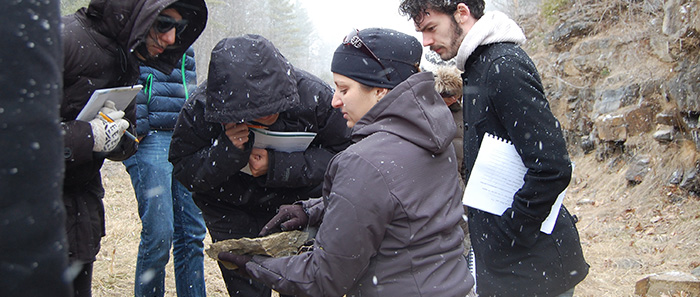
Mission Statement
Geoscience is the study of planet Earth, its materials, the processes that act upon them, and the history of the planet and its life forms since its origin. The mission of Skidmore's geosciences program is to apply the understanding of Earth processes to contemporary issues such as Earth resources, land-use planning, and global change. The program's curriculum includes ocean and atmospheric sciences, Earth surface processes, and the history of global change. Our courses are designed for students with a general interest in the geosciences as well as for students planning to pursue a graduate degree. We accomplish this mission by providing an environment in which students acquire sound scientific problem-solving, research, and communication skills.
Geoscience students obtain a strong foundation for lifelong learning, professional development in the geosciences, and enhanced career opportunities in other fields that require a broadly based background in this discipline. A liberal arts degree in geosciences prepares a student for a number of professional activities related to resource management, climatology, oceanography, hydrology, Earth hazards, land-use planning, and environmental consulting. Our department contributes to the broader mission of the college by providing courses that enhance student awareness of, and appreciation for, Earth's dynamic systems and the scientific methodologies by which they are understood. Our program complements and is complemented by environmental studies in additional to other natural sciences.
Geologic Setting
The Saratoga vicinity lies at the intersection of the Hudson and Mohawk River valleys. The region is bounded by the Proterozoic metasediments of the Adirondacks to the north, the Cambro-Ordovician Taconics to the east, the Devonian Helderbergs and Catskills to the south, and flat-lying Cambrian to Silurian strata to the west. The Woodlawn fault passes through the center of Skidmore's Jonsson Campus, which itself is underlain by the lowermost Ordovician stromatolite- and chert-bearing Gailor Dolomite southeast of the fault and Grenville age garnitiferous gneiss to the northwest. Immediately to the east of the campus, the Gailor is dropped into the shallow subsurface by the Saratoga fault system. East of this fault the Middle Ordovician Canajoharie Shale overlies the Gailor and serves as the cap rock beneath which the world-famous Saratoga Springs flow on the down-dropped eastern side of the fault. It can be truly said without exaggeration that the City of Saratoga Springs owes its existence, and Skidmore College owes its location, to a unique and complex interplay of geologic phenomena that extend in time from the Holocene back to the late Proterozoic Grenville Orogeny.The preceding could stand alone to afford any geosciences department a wealth of proximal field study sites for its students, but in Skidmore's case that need not suffice. The world famous stromatolite "reefs" of the uppermost Cambrian Hoyt Limestone outcrop immediately to the west of campus in the "Skidmore" quarry and at Lester Park. The latter is the site of the first report of stromatolites and of ooids in North America as well as the type locality of Cryptozoon proliferum, which is globally the first stromatolite to have been given Linnaean name. Just a few miles to the east of campus, Stark's Knob, New York's State's only "volcano," is exposed on the west side of the Hudson River north of Schuylerville. Stark's Knob is an Ordovician pillow basal that is now part of the Taconic overthrust belt. It is named for General John Stark, who mounted a battery of cannon on the site to block the retreat of the British army's northward retreat following the fall 1777 Battle of Saratoga, otherwise known as the turning point of the American Revolution.
On the way to Saratoga from Quebec, the British army traveled on lakes and through valleys that occupy down-dropped blocs of fault systems that are generically related to the Woodlawn and Saratoga faults. The Battle of Saratoga itself was largely fought on the topset beds of a Holocene delta complex of postglacial Lake Albany. A small part of the Jonsson Campus stood as a small island above the 450' high stand elevation of Lake Albany. Dune and beach deposits, along with glacial tills, constitute the surficial sediments of the campus and lake bottom varved clays underlie the sports fields to the west. A drumlin field and a buried channel of the Pleistocene Hudson River lie only a few kilometers to the west in the Towns of Greenfield and Milton. The channel fill, now known as the Kayaderosseras aquifer, is one of the Saratoga vicinity's primary sources of potable water.
Skidmore's proximity to such a unique and diverse set of geological field sites rivals almost any college or university in the country for teaching undergraduate courses in the geosciences and also in interdisciplinary venues that highlight the interactions between Homo sapiens and the natural environment.